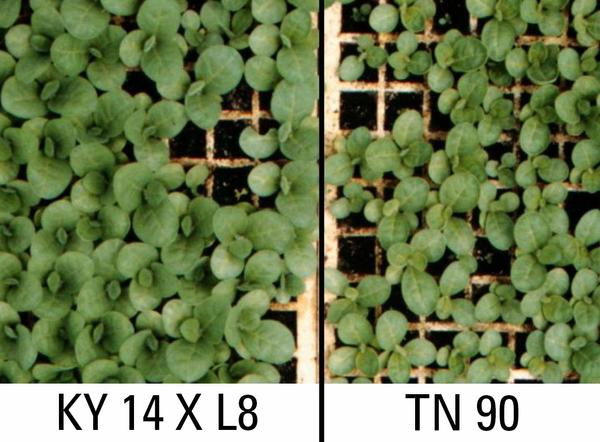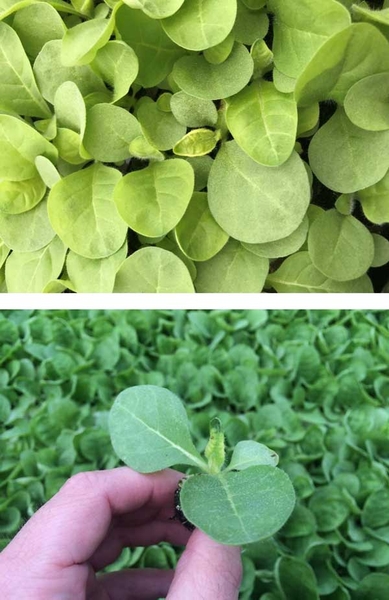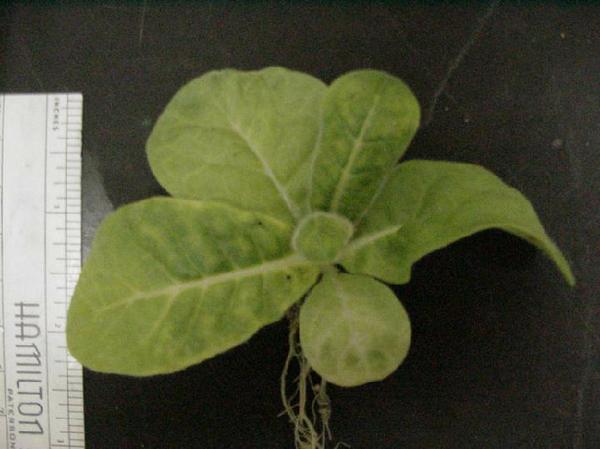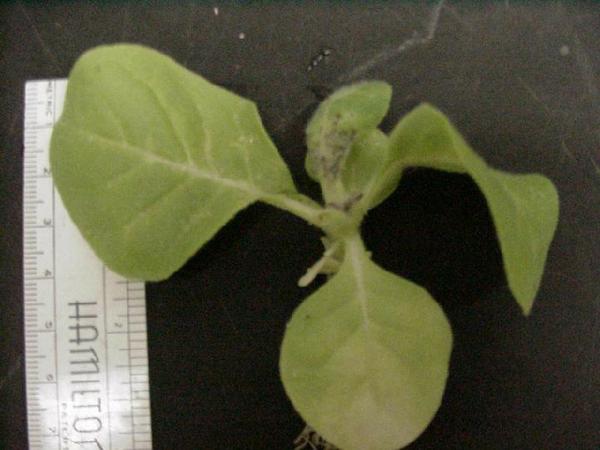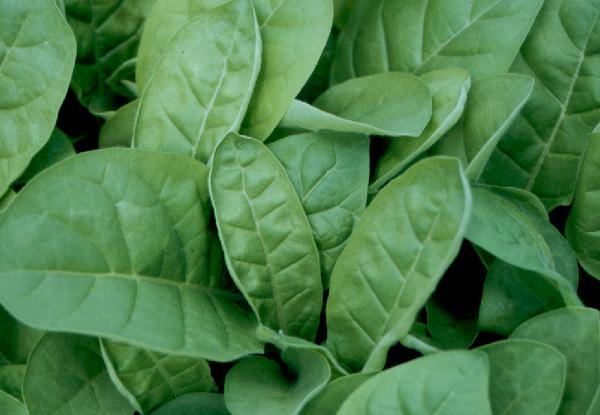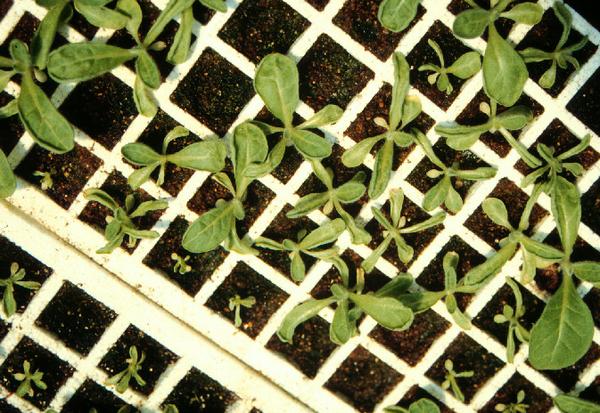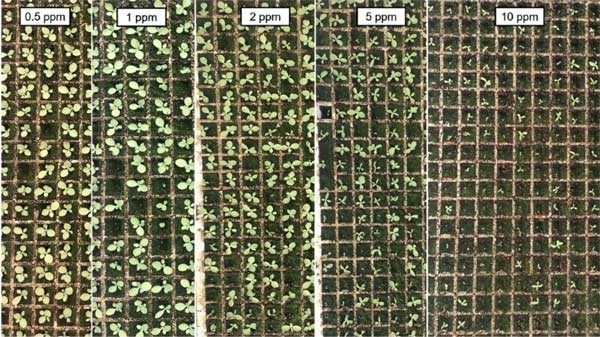Cold injury and boron (B) deficiency produce similar symptoms in tobacco seedlings grown in float greenhouses. In the past, what has often been mistaken for boron deficiency may have actually been cold injury, which does not require any corrective action.
Cold Injury
Cold injury is common in tobacco transplants grown in greenhouses. Seedlings of burley and flue-cured tobacco varieties are susceptible. The main symptoms are typically upward leaf cupping and puckering (Figure 1). Other symptoms include yellowing of the bud leaves and leaf narrowing (Figure 2). The affected trays may be uniformly distributed through the greenhouse. More often, however, the injury occurs in just a few cold spots randomly located throughout the greenhouse or along the curtains.
Tobacco varieties differ in their susceptibility to cold injury. Differences in the degree of injury are often apparent when varieties with different cold sensitivity are planted next to each other in the greenhouse. Figure 1, for example, shows the difference in injury to two burley varieties (flue-cured varieties also differ in their sensitivity to cold). Despite its name, cold injury is thought to result primarily from large fluctuations between daytime and nighttime temperatures rather than exposure to a specific low temperature. Greenhouse temperature can increase rapidly on sunny mornings if manual vents are not opened promptly; it is common for temperatures in an unvented greenhouse to increase by as much as 50°F within a few hours. Conversely, greenhouse temperature may plunge rapidly if curtains are not raised to trap heat at sunset. Diligent temperature management is the key to reducing cold injury, but even with the best management, mild cases may occur.
While cold injury sometimes slows growth, it does not cause permanent harm to the plants. Improved management of greenhouse temperatures is all that is needed to restore good growth. Cold injury is not associated with early flowering in the field.
Boron Deficiency
Boron deficiency is far less common than cold injury. Deficiency can occur when fertilizer without boron is used along with a water source that is low in boron. Boron deficiency almost never occurs if a fertilizer containing at least 0.01% boron is used at recommended rates. Producers are strongly encouraged to check greenhouse fertilizer labels to verify boron concentration, as slight differences are often indicated among formulations. The two most common water-soluble tobacco greenhouse fertilizer sources (SQM UltrasolTM 16-5-16 and 20-10-20) contain 0.02% boron.
Boron is needed for proper development of growing points. A mild deficiency affects the growing points at the tips of the leaves, causing the leaf to be puckered and misshapen, often cupping downward (Figure 3). As the deficiency becomes more severe, the growing point at the top of the stem (bud) is also affected. Corrective application of boron at this stage can restore normal growth. In severe cases, the bud will turn gray and die (Figure 4), and corrective measures at that stage are ineffective.
Visual diagnosis of mild boron deficiency can be difficult. Leaf analysis is the preferred method of diagnosis. The entire aboveground part of the plants should be collected. You may need to collect at least 50 seedlings to get enough tissue for analysis. Moreover, when diagnosing boron deficiency, you must account for boron concentrations in fertilizer, water sources, and soilless media; tobacco seedlings require a boron concentration of 1 to 2 parts per million (ppm) in sum from all three of these nutrient sources. Boron concentration in soilless media varies across brands, ranging from 0.05 to 0.30 ppm. If leaf tissue analysis confirms boron deficiency, apply borax directly to the float water at a rate of 0.2 oz/100 gal to supply 1.5 ppm boron.
Boron Toxicity
Boron can be very toxic to tobacco seedlings, and only a tiny amount is needed for good growth. Slight overapplication causes temporary leaf deformation (Figure 5), whereas excessive application of boron can result in severe, permanent seedling deformation (Figure 6 and Figure 7).
Use of Solubor, borosol, or borax to supply boron is advisable only in cases of a confirmed deficiency. The danger of boron toxicity from overapplication of foliar boron is far greater than any potential growth benefit. A fertilizer with at least 0.01% boron should be used if the greenhouse source water contains less than 2 ppm boron. It is especially important to use fertilizer with boron if the source water has less than 0.5 ppm boron. All water-soluble fertilizers contain a statement of boron concentration on the label. Be aware that different brands or formulations of the same fertilizer can contain different amounts of boron.
Recent Research
An extensive study was conducted with both burley and flue-cured tobacco in the North Carolina State University Phytotron. Controlled temperatures and several boron rates were used to determine if cold injury and boron deficiency are related. Cold temperatures slightly delayed boron uptake, even when boron was present in the float solution in adequate amounts. However, boron levels in transplanted seedlings were similar. Boron levels in the float water did not affect the appearance of cold injury; therefore, growers should not attempt to cure cold injury with foliar boron.
It was very difficult to produce boron deficiency under research conditions. Painstaking steps were required to eliminate all boron from greenhouse source water and fertilizer. The damage pictured in Figure 3 and Figure 4 resulted from several attempts to remove all boron from the production system; such conditions should be rare in a standard greenhouse. Our research led us to conclude that what is often interpreted as boron deficiency in greenhouse tobacco seedlings is actually the result of cold injury.
Summary
As you produce tobacco transplants, keep in mind the following points in managing cold injury and boron.
- Carefully manage greenhouse temperatures to minimize cold injury. Maintain daytime temperatures below 90°F and nighttime temperatures above 55°F after maximum germination is achieved (about 14 to 20 days after seeding).
- Note that a small amount of cold injury is normal, and warmer temperatures will correct visual deformities.
- Use fertilizer with at least 0.01% boron unless the boron concentration in the source water exceeds 2 ppm (in this case, you should use an alternative water source).
- Do not use supplemental boron applications unless a deficiency is confirmed by tissue analysis.
Additional Resources
“Producing Healthy Transplants in a Float System.” In Flue-Cured Tobacco Guide. NC State Extension. AG-187. Updated yearly.
Tobacco – Boron (B) Deficiency. Tobacco Nutrient Information. NC State Extension.
North Carolina Department of Agriculture & Consumer Services, Agronomic Services, Diagnostic Laboratory Services (including plant tissue analysis, solution analysis, and soilless media analysis)
Acknowledgments
The NC Tobacco Research Commission funded the research described here. This publication is a revision of an earlier version. The authors thank J. Rideout, L. Overstreet, L. Fisher, and D. Osmond for their original contributions.
Publication date: Feb. 22, 2019
Reviewed/Revised: Aug. 12, 2024
AG-439-54
N.C. Cooperative Extension prohibits discrimination and harassment regardless of age, color, disability, family and marital status, gender identity, national origin, political beliefs, race, religion, sex (including pregnancy), sexual orientation and veteran status.

